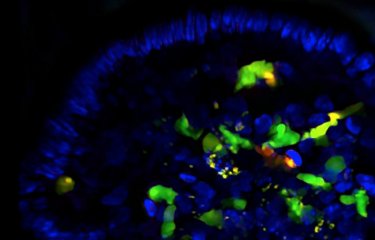With the ultimate aim of combating antibiotic resistance acquired by bacteria during evolution, researchers from the Institut Pasteur and CNRS have managed to shed light on one of the mechanisms of DNA recombination in bacteria.
Resistance genes are transferred between pathogenic bacteria via different pathways, but always as a single strand of DNA. One of the main players in these transfers is the integron — a genetic element that enables bacteria to acquire new genes and quickly adapt to environmental stress. The new genes are located in a structure called a "cassette" for integration into the bacteria's genome. Cassette integration reactions are controlled by a recombinase — the integrase — which is synthesized by the integron. These are atypical reactions in terms of DNA recombination, as the site in the cassettes is structurally different from traditional sites in other recombinant systems.
Integrases became differentiated from other recombinases 300 million years ago. They have evolved a new resolution pathway enabling the integration of new genes in the form of single-stranded DNA. In evolutionary terms, the new recombination pathway is so different that it is considered as functional innovation rather than adaptation. The team led by Didier Mazel, head of the Bacterial Genome Plasticity Unit (Institut Pasteur/CNRS), investigated whether integrase was only specialized in performing recombination via this new pathway or whether it was still capable of carrying out recombination "in the traditional way", i.e. retaining its ancestral activity.
In this study, the researchers observed that the integrase has indeed retained its ancestral activity on double-stranded DNA despite having a protein domain to avoid it when recombining single-stranded DNA. This means that integron integrases perform a substrate-dependent switch in recombination pathways, an unprecedented phenomenon in DNA recombinases. Furthermore, this article, published in Nature Communications, shows that the innovation process took place gradually here, as the ancestral activity and new activity coexist. Examples of such smooth transitions during functional innovation are extremely rare.
"To block the dispersal of antibiotic resistance genes, it is essential to elucidate the mechanisms underlying the transfer of genetic material from one bacterium to another", explains José Escudero (CNRS/Institut Pasteur), lead author of this study.
Source
Unmasking the ancestral activity of integron integrases reveals a smooth evolutionary transition during functional innovation, Nature Communications, march 10, 2016
Jose Antonio Escudero (1,2), Celine Loot (1,2), Vincent Parissi (3), Aleksandra Nivina (1,2,4), Christiane Bouchier (5), Didier Mazel (1,2)
(1) Institut Pasteur, Unité de Plasticité du Génome Bactérien, Département Génomes et Génétique, 28 Rue du Dr Roux, 75015, Paris, France.
(2) CNRS, UMR3525, 28 Rue du Dr Roux, 75015, Paris, France.
(3) Laboratoire de Microbiologie Fondamentale et Pathogénicité UMR-CNRS 5234. Bat. 3A 3e étage, 146 rue Léo Saignat, 33076, Bordeaux Cedex.
(4) Université Paris Descartes, Sorbonne Paris Cité, 75006, Paris, France.
(5) Institut Pasteur, Genomics platform, 28 Rue du Dr Roux, 75015, Paris, France.
Mis à jour le 10/03/2016





